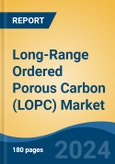Energy Storage is the fastest growing segment, Europe is the largest regional market
Speak directly to the analyst to clarify any post sales queries you may have.
10% Free customizationThis report comes with 10% free customization, enabling you to add data that meets your specific business needs.
Key Market Drivers
The Global Long-Range Ordered Porous Carbon (LOPC) Market is significantly propelled by the surging demand for advanced energy storage systems, driven by the electrification of transportation and the expansion of renewable energy integration. LOPC materials offer superior properties such as high surface area and controlled pore structures critical for enhancing the performance of next-generation batteries and supercapacitors.This imperative is evident in the automotive sector, where, according to an IEA report, in 2023, the deployment of batteries for electric vehicles grew by 40 percent with approximately 14 million new electric vehicles manufactured. Concurrently, the rising adoption of lightweight material applications acts as another pivotal market driver. Industries such as automotive and aerospace increasingly seek materials that offer an optimal strength-to-weight ratio to improve fuel efficiency and reduce emissions. Carbon fiber composites, a category benefiting from advancements in porous carbon structures, are integral to these efforts.
Key Market Challenges
The primary challenging factor for the Global Long-Range Ordered Porous Carbon (LOPC) Market is its high production costs. This elevated cost structure directly impedes the widespread adoption and commercialization of LOPC materials, particularly in sectors highly sensitive to pricing. While LOPC offers superior performance characteristics critical for next-generation applications, its manufacturing expenses often render it less competitive against more established or rapidly cost-optimized materials. For instance, in the energy storage sector, a key application area for LOPC, the cost of competing lithium-ion battery storage devices saw a significant reduction, falling to less than $200 per kWh in 2023 from approximately $800 per kWh in 2013, according to the International Energy Agency. This demonstrates the aggressive cost-down pressures present in markets where LOPC seeks to gain traction.Key Market Trends
Long-Range Ordered Porous Carbon is increasingly significant in advanced separation and filtration, utilizing tunable pore sizes and high surface areas for superior selectivity. The global demand for cleaner water and efficient industrial processes propels this trend. According to the International Desalination Association (IDA) in their 2024 yearbook, global installed desalination capacity surpassed 120 million cubic meters per day in 2023, highlighting the critical need for advanced membrane technologies. LOPC-based membranes offer enhanced fouling resistance and high flux for critical applications.Key Market Players Profiled:
- Applied Materials, Inc.
- BASF SE
- Mitsubishi Chemical Group Corporation
- Cabot Corporation
- Zeolyst International
- Albemarle Corporation
- Calgon Carbon Corporation
- Entegris, Inc.
- Sumitomo Chemical Co., Ltd.
Report Scope:
In this report, the Global Long-Range Ordered Porous Carbon (LOPC) Market has been segmented into the following categories:By Application:
- Energy Storage
- Chemical Catalysis
- Ion Screening
- Others
By Region:
- Asia-Pacific
- North America
- Europe
- South America
- Middle East & Africa
Competitive Landscape
Company Profiles: Detailed analysis of the major companies present in the Global Long-Range Ordered Porous Carbon (LOPC) Market.Available Customizations:
With the given market data, the publisher offers customizations according to a company's specific needs. The following customization options are available for the report.Company Information
- Detailed analysis and profiling of additional market players (up to five).
This product will be delivered within 1-3 business days.
Table of Contents
Companies Mentioned
The companies profiled in this Long-Range Ordered Porous Carbon (LOPC) market report include:- Applied Materials, Inc.
- BASF SE
- Mitsubishi Chemical Group Corporation
- Cabot Corporation
- Zeolyst International
- Albemarle Corporation
- Calgon Carbon Corporation
- Entegris, Inc.
- Sumitomo Chemical Co., Ltd.
Table Information
| Report Attribute | Details |
|---|---|
| No. of Pages | 180 |
| Published | November 2025 |
| Forecast Period | 2024 - 2030 |
| Estimated Market Value ( USD | $ 0.27 Billion |
| Forecasted Market Value ( USD | $ 0.35 Billion |
| Compound Annual Growth Rate | 4.3% |
| Regions Covered | Global |
| No. of Companies Mentioned | 10 |









